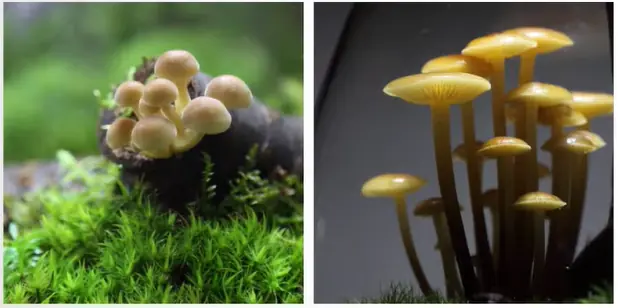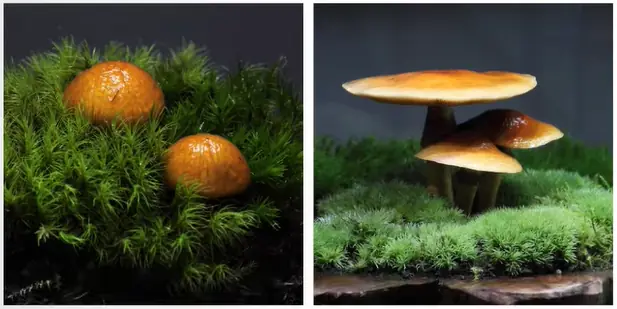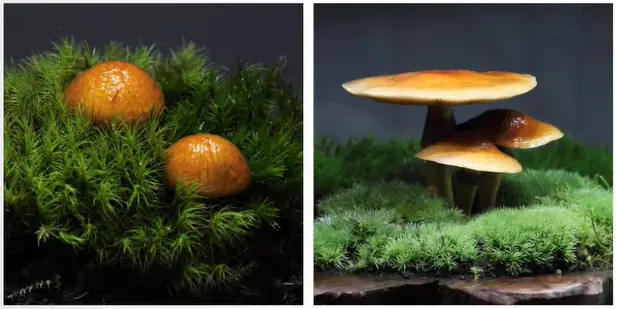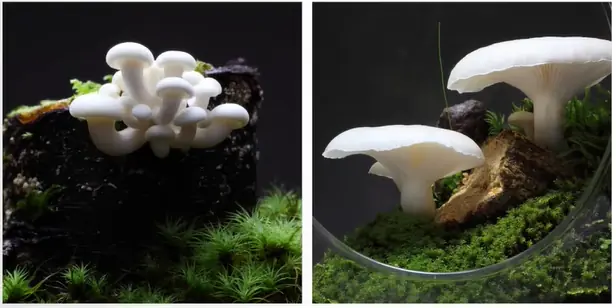Finishing a minimalistic, and eye-catching terrarium design is one of the most satisfying parts of the building them. And a mushroom terrarium has is just that. An articulate representation of a part of the forest, enclosed in glass. Moss, rocks, a small fern, and lots of mushrooms.
So, here’s how they work, and how to build one.
A mushroom terrarium is one of the most fascinating projects to make. And unsurprisingly ,as fungi, mushrooms play by a few different rules than plants. So making terrariums with them is also a bit different than with plants.
For one, mushrooms cannot be planted in their adult state, but grown from mycelium from within the terrarium (which is bought via a grow kit).
The period during which mushrooms grow is very short and lasts about 1 to 2 weeks. The finished scene is very short-lived, but the shapes created by mushrooms are very beautiful, mysterious and they are the things that attract people.
The mushroom part is called the fruiting body and is similar to flowers when speaking about plants. Even if the fruiting body dies, the mycelium of the mushroom does not. As long as the mycelium is alive, mushrooms will keep growing more than once. My works actually produce mushrooms 2-3 times a year.
We create mushroom terrariums using mushrooms that grow from autumn to winter. The ideal conditions for a mushroom terrarium is when the temperature can be kept around 10 – 18 C. Summer is generally off season.
Molds and insects are more likely to occur in the summer, so it is not recommended. In summer, enjoy it as a moss terrarium, and simply plant the mushrooms later. This video shows you how to remake and grow new mushrooms.
Mushroom terrariums are always open, as mushrooms need fresh air to grow. They and are usually compliment by a moss and sometimes a tiny fern.
Mushrooms don’t need any specific layering, dirt, etc. they don’t grow roots and purely exist on the surface.
So, the only materials needed for a mushroom terrarium are:
Considering that the mushrooms will be the spotlight of a mushroom terrarium, you need to pick a mushroom that fits your design and idea for the terrarium.
To keep things simple I’ll list the mushrooms that have very similar growth needs, and that I personally like:

They are a little slimy and become glossy when sprayed.

They are thick and firm. Slimy and very cute when young.

Easiest to grow in room conditions.

White oyster mushroom variety. A beautiful pure white mushroom.
Now that you have all of your materials ready, we can begin putting together the terrarium. As far as the layout of the terrain goes, you can structure the soil any way you’d like.
You can chose between using a combination of pumice and peat, or just akadama soil. It won’t make a difference in terms of growth of the moss and mushrooms, but if you’re also planting a small fern, then using pumice as the bottom layer, followed by peat, and akadama at the top is ideal.
If you’re just using moss, and mushrooms, then you could use akadama soil entirely.
The major part of building a mushroom terrarium is planting the mushrooms. Mushrooms are the fruit of the fungi. So what you’ll be planting is mycelium which is the vegetative part of the fungus. Ready to plant mycelium can be easily obtained via a grow kit
You can plant it directly in the soil, but consider that when the mushrooms die off you will have a hard time getting it out and replacing it with new mycelium without trashing the layout of the terrarium.
To avoid this, you can plant the mushrooms in three different ways:
Mushroom terrariums are truly one of the kind and give out an aesthetic unlike any other type of terrarium. They’re also harder to cultivate, and when they bloom it’s short and sweet.
While they look spectacular on their own, you can get creative and add a few decorations to bring out a desired theme.
To wrap it up, here are some great examples of such terrariums to give you a few ideas: